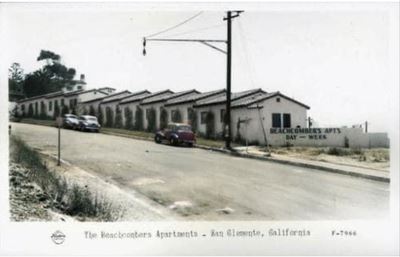Article and photos by Christine Lambert, Architect, AIA, NCARB
San Clemente and neighboring Capistrano Beach have just one vintage beachfront hotel each The Beachcomber Inn in San Clemente and the Capistrano Seaside Inn in Capo Beach were the only historic oceanfront hotels available to tourists in this area, but the Capistrano Seaside Inn has been in ruins for years. The Capistrano Seaside Inn building is currently being renovated and soon will reopen, giving visitors the option of a second historic seaside hotel experience.
The Beachcomber Inn sits close to the beach above the pier in San Clemente. The Beachcomber has maintained its charm since it was built in 1947. It is one of the very few beachside hotels built in the Spanish Colonial Revival style in South Orange County The building is designated us a historic property by the city and is protected from any major changes.
The Capistrano Seaside Inn was built around 1930. For years, it was considered one of the best places to stay affordably at the beach even though one had to cross Pacific Coast Highway to get to the beach. The Capistrano Seaside inn was doing well until the late 1980s. Tourists could catch a ride to the hotel from the train station and there was even a gourmet French restaurant on it premises. In its earl er days, the inn hosted many famous guests. It fell into disrepair, out will reopen soon as a historic seaside hotel..
San Clemente and Capistrano Beach/Dana Point have newer hotels, but nothing is charming and as close to the beach as these two rustic hotels.
Years ago, when San Clemente was first established in the 1920s, the San Clements Hotel on Avenida Del Mar was built for the tourists. There was also a motel night across the pier where the parking lot is today, but it was demolished years ago.
San Clemente was designed as the ultimate resort town with a fishing pier, an Olympic size swimming pool, horseback riding and many other amenities. It’s amazing that there were so few beachfront hotels.
When Ole Hanson, one of the founding fathers of San Clemente, master planned the community in the 1970s, he built the San Clemente Hotel on Avenida Del Mar. He was in the process of building a huge resort across the street from T-Street Beach when the Great Depression happened, and he had to stop the design of the project. Today, there are houses above T-Street instead of a resort.
Years ago, many visitors including movie stars, passed through San Clemente on their way to the San Diego, which would have been a natural stopping off point. In the 1920s, the only way to San Diego was along the narrow two-lane highway 1, also known as El Camino Real The journey probably would have taken at least six hours by car. The train tracks along the beach had already been built in the 1880s between Los Angeles and San Diego. The freeway, Interstate 5, which cut through the middle of town, wasn’t built until 1960. This would have been the ideal location for more beachfront hotels.

Christine Lampert, Architect, AIA, NCARB
 Christine Lampert of Lampert Dias Architects is a member of the American Institute of Architects and is certified with the National Council of Architectural Registration Boards. She has lived in San Clemento for more than 46 years and until recently also resided part time in Hong Kong.
Christine Lampert of Lampert Dias Architects is a member of the American Institute of Architects and is certified with the National Council of Architectural Registration Boards. She has lived in San Clemento for more than 46 years and until recently also resided part time in Hong Kong.
